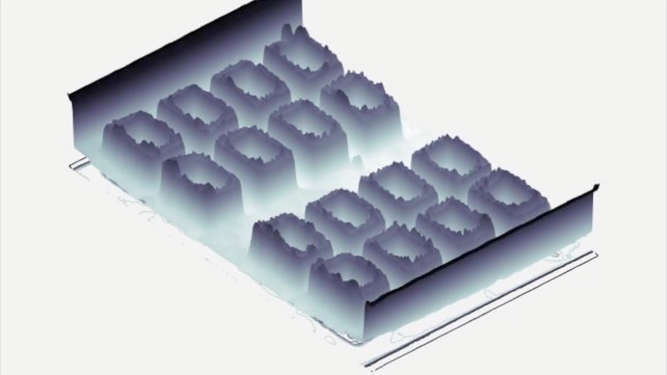


Microcompartiments thermo-activated for the encapsulation of single cells. The biological cells are injected when microcages are open (for T > LCST). They are trapped when microcages are raised and closed (with T < LCST).
Thermo-responsive hydrogels are used as autonomous micro-actuators that are integrated in lab-on-a-chip. Hydrogel microcages swell/collapse on demand with a small temperature change to encapsulate single cells. In our case, the grafting and patterning of the hydrogels are performed before the microfabrication of the chip, which undeniably offers a better control of the synthesis, a better reproducibility and no chemical pollution that prevented a biotechnological breakthrough until now.
Proof of concept has thus been established for micro-cage functions with excellent performance in terms of spatial resolution and response time: the micro-compartments switch from open to closed state in less than a second with a small change in temperature. With hydrogel actuators, a significant gain in screening capabilities, at reduced cost, can be achieved compared to microfluidic technologies based on pneumatic valves and drop-based encapsulation. These hydrogel micro-compartments allow isolation, labeling, and lysis of cells without any contamination. This allows to rely and study the phenotype and genotype of a cancerous tissue for example. This project is developed in partnership with the Minos Biosciences startup (Patrick Tabeling, Hubert Geisler, Gaël Blivet and Andrew Griffiths).

Les hydrogels thermo-stimulables sont utilisés comme micro-actionneurs autonomes qu’on intègre dans les laboratoires-sur-puces. Les micro-cages d’hydrogels gonflent/dégonflent à la demande grâce à un petit changement de température pour encapsuler des cellules uniques. Dans notre cas, le greffage et la texturation des hydrogels sont réalisés avant la micro-fabrication de la puce, ce qui offre indéniablement un meilleur contrôle de la synthèse, une meilleure reproductibilité et d’éviter les pollutions chimiques qui empêchaient jusqu’à maintenant une percée biotechnologique.
La preuve de concept a ainsi été établie pour des fonctions micro-cages avec d’excellentes performances en termes de résolution spatiale et de temps de réponse : les micro-compartiments passent de l’état ouvert-fermé en moins d’une seconde avec un petit changement de température. Avec les actionneurs à hydrogels, un gain important dans les capacités de criblage, à coût réduit, peut être atteint en comparaison avec les technologies microfluidiques basées sur les vannes pneumatiques et l’encapsulation en gouttes. Ces micro-compartiments hydrogels permettent d’isoler, d’étiqueter, et de lyser les cellules sans aucune contamination. Cela permet de lier et d’étudier le phénotype et le génotype d’un tissu cancéreux par exemple. Ce projet est développé en partenariat avec la startup Minos Biosciences (Patrick Tabeling, Hubert Geisler, Gaël Blivet et Andrew Griffiths).

Patent Number FR1251722. February 24, 2012. “Microchannel with an opening and/or closing and/or pumping device”.
Patent Number EP 21305027.1. January 12, 2021. “Analysis of cells and/or organelles in hydrogel cages”.
D’Eramo, L.; Chollet, B.; Leman, M.; Martwong, E.; Li, M.; Geisler, H.; Dupire, J.; Kerdraon, M.; Vergne, C.; Monti, F.; Tran, Y.; Tabeling, P. Microfluidic actuators based on thermo-responsive hydrogels. Nature Microsyst. Nanoeng. 2018, 4, 17069.
https://doi.org/10.1038/micronano.2017.69
